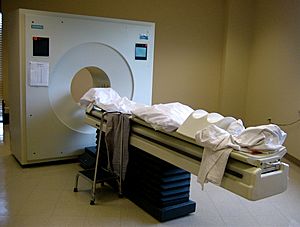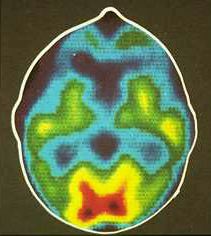Positron emission tomography facts for kids
Positron Emission Tomography, usually called PET, is a special way doctors can look inside your body. It's a type of medical imaging that helps them see how your organs and tissues are working.
A PET scan uses a very small amount of a special substance called a tracer. This tracer is a tiny bit radioactive, but it's safe for medical use. When the tracer is put into your body, it travels through your blood. It goes to parts of your body that are very active, like certain areas of your brain or a growing tumor. The PET scanner then finds the tiny signals from the tracer and turns them into a detailed picture. This picture shows which parts of your body are most active.
PET scans are often used to find problems like tumors or to see how well certain treatments are working. The tracers used are often like sugar, or are sugars that have been changed slightly for the scan.
The machines for PET scans are quite expensive. Also, the special tracers only last for a short time, usually about 30 to 60 minutes. This means they have to be made fresh for each scan and cannot be stored for a long time.
Contents
How a PET Scan Works
A PET scan works by finding tiny particles called positrons. These positrons come from the special tracer that is put into your body. When a positron meets another tiny particle called an electron, they disappear and create two energy signals.
Detecting the Signals
The PET scanner has special detectors all around it. These detectors can find the energy signals that are created. The scanner then uses these signals to figure out exactly where the tracer is in your body.
Creating the Image
Once the scanner knows where the tracer is, a computer uses this information to build a detailed 3D picture. This picture shows which parts of your body are using a lot of the tracer. For example, if a part of your brain is very active, it will use more of the sugar-like tracer and show up brightly on the scan. This helps doctors see if everything is working correctly or if there are any problems.
What PET Scans Are Used For
Doctors use PET scans for many different reasons. They are very helpful because they can show how organs are working, not just what they look like.
Finding Diseases
One of the main uses for PET scans is to find diseases like cancer. Cancer cells often use more sugar than healthy cells, so the sugar-like tracer will gather in tumors, making them easy to see on the scan. PET scans can also help doctors:
- Find out if cancer has spread to other parts of the body.
- Check if cancer treatment is working.
- Look for problems with the brain, like Alzheimer's disease or epilepsy.
- See how well the heart is working after a heart attack.
Different Tracers for Different Scans
Doctors choose different types of tracers depending on what they want to look at. For example, a tracer that acts like sugar is good for finding cancer. Other tracers might be used to look at blood flow or how certain chemicals are used in the brain.
Images for kids
See also
 In Spanish: Tomografía por emisión de positrones para niños
In Spanish: Tomografía por emisión de positrones para niños







